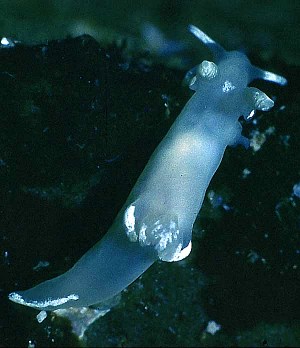
Trapania pallida
Kress, 1968
Order: NUDIBRANCHIA
Suborder: DORIDINA
Superfamily: ANADORIDOIDEA
Family: Goniodorididae
DISTRIBUTION
Atlantic coast of Europe from Spain to British Isles.
PHOTO
Wembury, Plymouth, England, 31 May 1975. Photo: Bernard Picton
Translucent white with opaque white patches or streaks in the dorsal midline and posterior foot. Also white on oral tentacles, lateral processses, gills and rhinophores. Grows to about 15mm long.
Reference:
• Kress, A. (1968). Trapania pallida sp. nov. (Opisthobranchia, Gastropoda), a genus new to Britain. Proceedings of the Malacological Society of London 38: 161-165.
Rudman, W.B., 2001 (February 8) Trapania pallida Kress, 1968. [In] Sea Slug Forum. Australian Museum, Sydney. Available from http://www.seaslugforum.net/find/trappall
Related messages
Re: Trapania pallida feeding
April 30, 2010
From: Dominique Horst
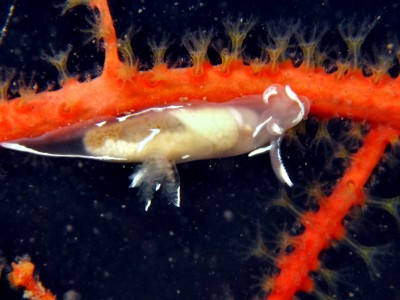
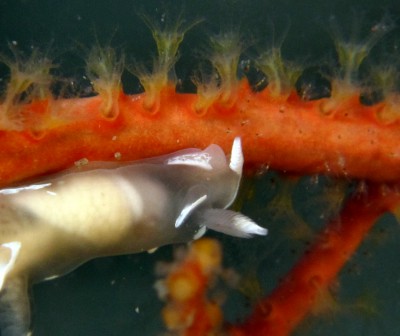
Concerning message #23180:
Dear Bill,
Thinking about this last message I've try to understand why T. pallida could stay a so long time on Leptogorgia sarmentosa, if its not for feeding on?
Looking carefully on all pictures I did, I'm quit sure that it is feeding on the gorgonian but not on the polyps but on very small polyps that could be entoprocts....
The question is could entoprocts live on gorgonians like they do on Dysidea or other sponges? Maybe you or Bernard Picton may have the answer?
If they do, this would be a clear explanation of the presence of Trapania pallida on L. sarmentosa.
The only other pictures I've seen of T. pallida are those done by Gilles Cavignaux and also on L. sarmentosa. Could this be only a hazard?
Locality: Cagnes, 39 m, France, Mediterranean sea, 30 January 2010, muddy. Length: 5 mm. Photographer: Dominique Horst.
Kind regards,
Dominique
dominique.horst@wanadoo.fr
Horst, D., 2010 (Apr 30) Re: Trapania pallida feeding. [Message in] Sea Slug Forum. Australian Museum, Sydney. Available from http://www.seaslugforum.net/find/23567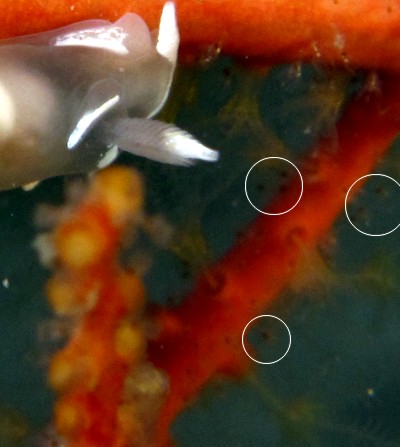
Dear Dom,
I agree that your Trapania pallida do seem to spend a lot of time on these gorgonian colonies, but if they were feeding on the gorgonians I would expect to see some sign of them attacking the polyps but the fact that the polyps are fully extended even when the Trapania is nearby - and none appear to be damaged or missing - suggests the gorgonian polyps are not the target. Also the Trapania seem to be on the side of the branch without polyps
Kamptozoans do seems to live in association with various invertebrates, but I am not sure if they have been found with any gorgonian. Bernard may know. However while looking at your hi resolution photos I noticed some dark brown spots which are definitely not holes in the gorgonian colony [see rings]. If you look at the kamptozoa Fact Sheet you will see I find brown spots quite a good indicator of kamptozoa individuals. It wouldn't surprise me if the brown spots in your photos are the stomachs of kamptozoa - then again I could be quite wrong.
Best wishes,
Bill Rudman
Trapania pallida from French Mediteranean
April 16, 2010
From: Dominique Horst
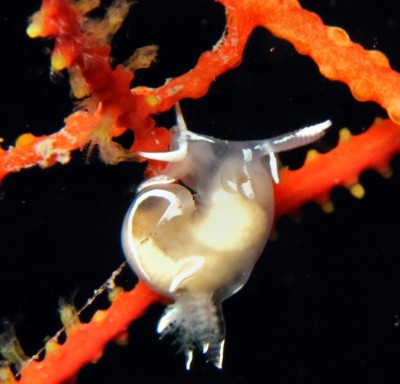
Concerning message #3768:
Hi Bill,
I've identified this as Trapania pallida. It is the first time I have seen it. It apparently feeds on Cnidarian (Leptogorgia sarmentosa).
Except a friend of mine in mid January I've never read or see anything about this species in Mediterranean...
Locality: Cagnes, 40 m, France, Mediterranean sea, 30 January 2010, muddy. Length: 5 mm. Photographer: Dominique Horst.
Kind regards,
Dominique
dominique.horst@wanadoo.fr
Horst, D., 2010 (Apr 16) Trapania pallida from French Mediteranean. [Message in] Sea Slug Forum. Australian Museum, Sydney. Available from http://www.seaslugforum.net/find/23180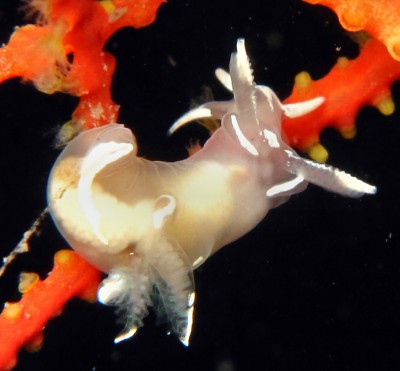
Dear Dom,
This certainly looks like T. pallida to me and I can't find any record of it from the Mediterranean so you may have documented an interesting range extension.
Concerning its food. Bernard Picton's message [#3767] was one of the first that clealry showed that species of Trapania feed on entoprocts [Kamptozoa]. Negatives are hard to prove, but I would be surprised if T. pallida fed on a cnidarian - it is certainly not a normal food of any dorid species.
Best wishes,
Bill Rudman
The food of Trapania pallida !!
February 12, 2001
From: Bernard Picton
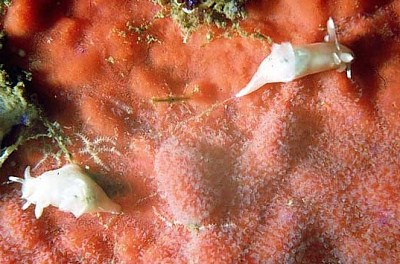
Hi Bill,
I just read your comment on Trapania goslineri:
"Dear Mike,
Thanks for the photo. What are species of Trapania doing on sponges? One wish I have for the new year is that someone shows me conclusive evidence that they feed on sponges, or if not some evidence of what they do feed on. For that matter, the same hold true for species of Siphopteron and other gastropterids.
Best wishes,
Bill Rudman. "
So here's your wish! - in situ photographs of Trapania pallida - Isla Onza, Galicia, Spain -July 1978. (Sorry about the poor quality - first time using a new Nikonos/flash combination I think, overexposed and unsharp. I searched for them last night and finally found them in a box in the garage where they'd been for the last four years so they're a bit fungusy! They weren't really useable but the scanner did get something off them.)
Now in my experience, Trapanias are as rare as hens teeth, but at this time and in this area they were all over the place in great gaggles! (Two species - see next email). They weren't eating the sponges but were cutting clear areas through the Entoprocts which were themselves overgrowing the sponges.
Bernard
bernard.picton.um@nics.gov.uk
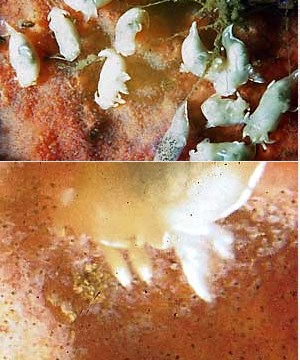
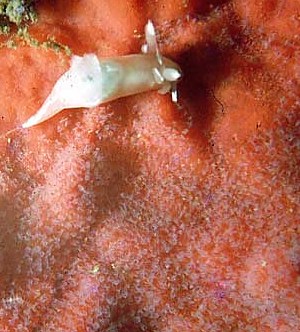
Dear Bernard,
Thanks very much for these observations and for the information on feeding in Trapania tartanella - a very interesting find.
For those of you not familiar with the Entoprocta, they are a small phylum of sessile aquatic animals with a ring of tentacles which make them look superficially like hydroids. However, unlike hydroids, they have a gut that loops around with both a mouth and an anus which both open in the ring of tentacles. They are stalked, and some are solitary animals and others live as part of colonies, joined much like hydroids, by a root-like system of stolons. For a long time they were considered to be Bryozoans but are now considered a distinct and unrelated phylum. Because of this some people feel we should use the word 'Ectoprocta' for the stream-lined phylum Bryozoa [minus the Entoprocta] but this is proving almost as confusing as continuing to us Bryozoa. To add to the confusion the names 'Kamptozoa' and 'Calyssozoa' have been suggested to replace the 'Entoprocta'.
Bill Rudman.
Rudman, W.B., 2001 (Feb 12). Comment on The food of Trapania pallida !! by Bernard Picton . [Message in] Sea Slug Forum. Australian Museum, Sydney. Available from http://www.seaslugforum.net/find/3767Trapania pallida from England
February 12, 2001
From: Bernard Picton

Here is a close-up photo of Trapania pallida to accompany the photos of it feeding.
Details: Wembury, Plymouth, England - 31 May 1975.
Best wishes,
Bernard
bernard.picton.um@nics.gov.uk
Picton, B., 2001 (Feb 12) Trapania pallida from England. [Message in] Sea Slug Forum. Australian Museum, Sydney. Available from http://www.seaslugforum.net/find/3768Thanks Bernard,
Bill Rudman.
